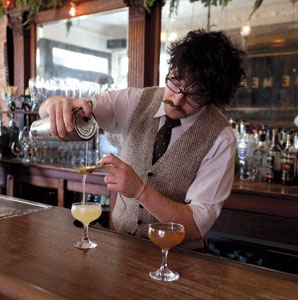 As bars, shops, and restaurants across the country draw inspiration from olde-tyme Americana, T+L ponders the next Gilded Age.
As bars, shops, and restaurants across the country draw inspiration from olde-tyme Americana, T+L ponders the next Gilded Age.
I’ll wager you two bits your bartender’s wearing muttonchops and a waistcoat. If not you should ask for your money back, order your Sazerac elsewhere.
A decade into the 21st century, much of the populace seems to believe it’s the late 19th to mid-20th. Look around: at the schoolhouse lamps and Edison bulbs illuminating so many trendy haunts; at the grandmotherly comfort food we’re ordering for dinner; at our unquenchable thirst for arcane cocktails. Some nights it’s like the whole nation’s been doused in rye whiskey and sepia ink. Bamboo sprouts in Aalto vases give way to daisies in rusted tomato cans; aluminum Navy chairs to scuffed bentwoods. Rough is the new sleek, aged the new new.
Man. Remember the Future? Bright and shiny and prefixed with an i? How we embraced its clean lines, its space-age polymers, its lychee saketinis! The Future seems so last year. The Past is now. You could spend a weekend in any American city and never once enter the present tense, flitting from one time capsule to the next: fin de siècle–themed cocktail dens; rusticated taverns straight out of Melville; supper clubs serving “hamburger sandwiches.” The twenties are a favorite trope—witness the plethora of Joe-sent-me joints with giveaway names like Bugsy’s Speakeasy , Bathtub Gin & Co. , and the umpteen bars nationwide called Prohibition.
That this is a particularly urban phenomenon is curious. Once we looked to our cities for a vision of what was next. (For what came before, we had small towns.) Today’s metropolis is beginning to look a lot like Mayberry. Or Deadwood.
From Buckhead to Belltown, Williamsburg to Wicker Park, restaurateurs, hoteliers, shopkeepers, and saloon owners are turning back their salvaged grandfather clocks and decking the walls with bison heads and owl lithographs. Meanwhile, every indie musician has stolen his look from the cover of the Band’s first album. The hills are alive with the corduroy tones of Beard Rock.
Fashion, too, has discovered its inner Grover Cleveland. The designs of Billy Reid—whose boutique empire stretches from Charleston to Dallas—would have looked just as dashing on your great-grandfather, although that plaid car coat would’ve set him back eight months’ wages. The New York restaurant Freemans has made a cultlike brand of natty nostalgia, spawning its own menswear line, an antiquated barbershop, and a “sutlery” (what Lewis & Clark called a clothing store). Even J.Crew, Levi’s, and Fossil have gotten in on the olde-tyme Americana game, with campaigns evoking some grainy bygone era.
Why this obsession with the aesthetics of the past? Has a whole generation of men simply realized they look strapping in arm garters? The movement is driven largely by urban males, seeking a non-mockable model of masculinity and finding it in the mustaches and bitter liquors of their forebears. But the retro revival transcends gender, intersecting conveniently with the get-back rootsiness of the green movement: it is, after all, a natural extension of Reduce-Reuse-Recycle, fetishizing a lifestyle that’s literally hand-sewn and homegrown. The music, the clothing, the furnishings, the food and drink all celebrate the organic over the synthetic, the artisanal over the prefab. No doubt the trend also reflects a collective desire to unearth something we lost, forgot, or never had in the first place: our noble ideals of craftsmanship and honest work and, especially potent among city dwellers, the memory—real or imagined—of small-town America. There are reasons why Norman Rockwell is enjoying a revival.
The anachronistas are historically promiscuous, seldom faithful to one era alone. Like an iPod set on shuffle-by-decade, they can’t decide if they’re channeling Walt Whitman, Scott Joplin, or F. Scott Fitzgerald, or just mashing up all three. At most of these taverns and taprooms and haberdashers and sutleries, the only requirement is that everything be convincingly, indeterminately old.
Or at least appear so. The funny thing—given how much disused historic architecture languishes in American cities, begging for reinvention—is how many of these sepia-toned establishments are in fact brand-new, carved out of, say, a former Blockbuster Video. Their tin ceilings are no more genuine than those distressed-leather wing chairs from Restoration Hardware, and that warbly Sidney Bechet recording is no dusty 78 but an MP3 enhanced with the “vinyl crackle” effect. Walk into New York’s Bowery Hotel, all musty taxidermy and worn plank floors, and you’d swear it was a landmarked building. It was constructed five years ago. We may not know much about history, but we’ve become uncannily adept at faking it. Ah, well: authenticity, schmauthenticity. Another round, bartender—give us something nice and aged.
The top dogs of the new (old) breed.
Prohibition 56 E. Andrews Dr.; no phone; prohibitionatl.com
Brewer’s Art 1106 N. Charles St.; 410/547-6925
The Beehive 541 Tremont St.; 617/423-0069
In God We Trust 135 Wythe Ave.; 718/388-2012
Prime Meats 465 Court St.; 718/254-0327
Billy Reid 150 King St.; 843/577-3004
Violet Hour 1520 N. Damen Ave.; 773/252-1500
Bugsy’s Speakeasy 1948 W. 25th St., basement; 216/661-7070
The Edison 108 W. Second St.; 213/613-0000
Seven Grand 515 W. Seventh St., second floor; 213/614-0737
The Varnish 118 E. Sixth St.; 213/622-9999
Patterson House 1711 Division St.; 615/636-7724
The Breslin 1186 Broadway; 646/214-5788
Bowery Hotel 335 Bowery; 212/505-9100
East Side Social Club 230 E. 51st St.; 212/355-9442
Freemans Sporting Club 8 Rivington St.; 212/673-3209
Village Whiskey 118 S. 20th St.; 215/665-1088
Bourbon & Branch 501 Jones St., no phone; register at bourbonandbranch.com for password
Rickhouse Bar 246 Kearny St.; 415/398-2827
Bathtub Gin & Co. 2205 Second Ave.; 206/728-6069
Tavern Law 1406 12th Ave.; 206/322-9734